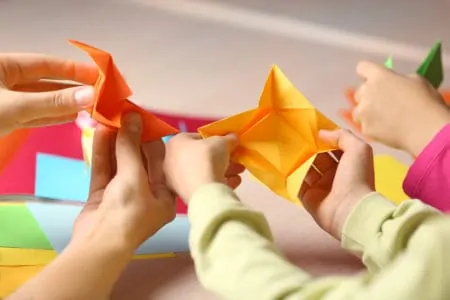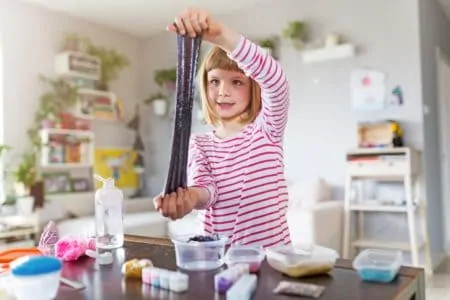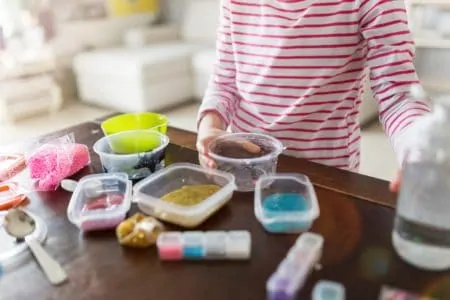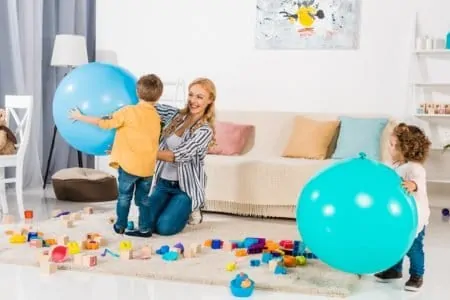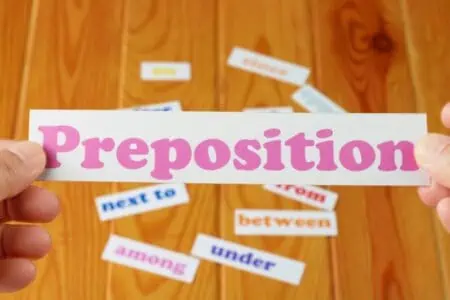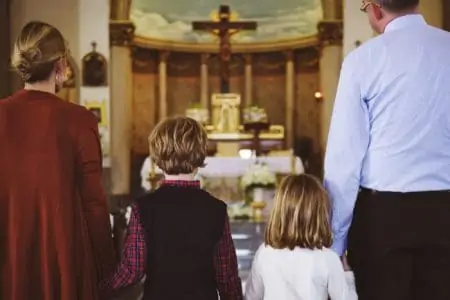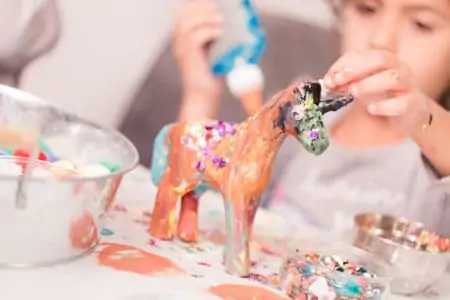Origami can be a wondrous hobby for kids. This paper craft requires beginning with a square of paper, making some folds, and having a beautiful end result. However, that is an oversimplification because origami is a precise art form.
Origami for kids is a complex activity steeped in history and tradition. It also has multiple physical and cognitive benefits for children.
In this guide, we’ll share 12 easy origami projects for beginners with video instructions.
Key Takeaways
- Origami improves fine motor skills, brain development, and teaches problem-solving skills.
- Simple origami projects can teach math concepts like fractions, geometry, and measurements.
- Creating origami requires following instructions and understanding sequencing, valuable life skills.
- Practicing origami can build self-esteem and help children learn to deal with failure.
Easy Origami Projects for Kids

To help you and your child enjoy the benefits of origami, we have put together a list of 12 starter projects.
These are simple enough that your child should be able to do them.
Fish Origami for Kids
This super simple origami fish tutorial for kids, takes you, slowly, through every fold. It is an excellent first project and is useful for teaching the concepts of halves and quarters.
You can create this fish with a single standard 6-inch square. If this is your child’s first project and they are still quite young, consider using a slightly larger square to make it easier for them.
Aitoh 9.75 x 9.75 inch paper is great for this.
Butterfly Origami for Kids
There are many origami butterfly tutorials available, but we like this one. It takes less than three minutes to create a butterfly, and the final model has a pleasing 3D quality you do not find in some other models.
Flower Origami for Kids
This simple and clear video walks you through a lily in about three minutes. Practice with fish and butterflies a few times and then move onto this origami.
These papers from Kool Krafts have some patterned sheets which are especially nice for these lilies.
Origami Games for Kids
These games deviate from the strictest definition of origami because they use items other than a single square of paper. However, they do require the same folding techniques.
This video has three games:
- Cockroach Climbers: You will need two 8×8 inch squares of slightly thicker paper, two lengths of thread, string, or similar, and glue.
- Jumping Bunnies: You will need two strips of paper measuring 2×12 inches, markers, and stick on eyes to decorate, if you wish.
- Caterpillar Race: You will need one strip of paper 2×12 inches for each caterpillar, scissors, and a marker for decoration.
Origami Puppet for Kids
Many of the origami puppets you see are multicolored or have teeth or tongues inside the mouth. These are fun, but if you don’t make the folds perfectly, the different colors or patterns do not line up correctly. That means the puppet doesn’t look right, which can be frustrating for kids.
So we have chosen this fish origami puppet for kids. It is fun to make and to play with. Best of all, you only need a square of paper in a single color.
Boat Origami for Kids
This origami boat will truly float in the water, which ups the fun element for kids. For this traditional-styled cute boat, you’ll only need a single square of paper. A six-inch square works well, but larger sheets make for bigger boats, which can be more fun if you plan to sail them.
Origami House for Kids
For this house, you will need two square sheets of paper. If you plan to make a number of houses, different colors are fun.
This one is for more advanced folders or children who are older. There are so many folds involved, it would prove too difficult and frustrating for younger children.
Frog Origami for Kids
This frog origami project is easy to follow along with, and it results in a frog that can truly hop. So, your child will end up with an origami project they can play with when the folding is done.
Only one sheet of origami paper is needed, and a six-inch square is best for a good, springy frog.
Origami Birds for Kids
There are two birds for your child to decide between. Or, they can make both if they have enough time on their hands.
These one-sheet swans are fun to make and have the added advantage of being cute gifts.
This bird is also a good choice because of the fun flapping wings. As they require a single sheet, it is easy to make an entire flock.
Origami Dinosaurs for Kids
Dinosaurs are animals kids seem to love, especially in the early elementary years. There is something so fascinating to them about these big, extinct creatures. They can make a variety with these three picks.
To make this T-Rex, you need a sheet of A4 paper. There are many folds to make, so this is best suited for more experienced crafters.
To make this brachiosaurus, you need a 6-inch square and some experience doing origami.
For this pteranodon, you also need a single 6-inch square.
Bunny Origami for Kids
These simple bunnies are made with a 4-inch square in the video but work equally well with a six-inch square.
There are some intricate folds to make, so you may have to supervise if you have some free time.
Paper Hearts Origami for Kids
Many origami hearts are flat shapes, but this version is “inflatable.” A six-inch square works for the basic heart, but these are fabulous when made with an 8-inch square.
What Is Origami?

Origami is the art of making folds in a square of paper to create a sculpture. The sculpture must be made without making any cuts to the paper, nor can any form of sticky tape or glue be used. It’s essentially paper-folding for kids or adults.
True origami does not allow any marking of the paper. However, in many origami tutorials for children, the addition of a dot for an eye or a line for a mouth can often be found.
What Is the Purpose of Origami?
Paper, as we know it today, was invented by the Chinese approximately 2,000 years ago (1). Initially, paper was a rare and expensive item. Therefore, it was used primarily by royal households, monks, and religious leaders for recording important texts.
It is thought that religious leaders and monks were the first to practice origami. These paper sculptures were made for ceremonial or religious purposes. Origami was also used to teach some basic principles of mathematics.
As paper became more widely available, origami was also practiced to create decorations and purely for the purposes of artistic enjoyment (2).
Is Origami Japanese Or Chinese?
While it is assumed by many that origami is a strictly Japanese pastime, it is most likely to have originated in China (3). However, in the 1600’s it became a popular artform in Japan and it is here that the first known written origami instructions were recorded in 1797.
At this stage, the practice was called orikata, meaning “folded paper.”
In the meantime, the Moors brought a form of mathematically-based paper folding to Spain. Here it was further developed into a practice known as papiroflexia.
The term origami emerged in Japan in the late 1800’s. As origami is a Japanese word, it became primarily seen as a Japanese activity.
Is Origami An Art Form?
Great minds have debated about what qualifies as art. However, if you believe art is creation of something purely for the pleasure of creating it, then origami can be considered an art form.
Why Is Origami Called Origami?
The name origami is generally thought to originate from two smaller Japanese words. First is ori which means to fold and second is kami, meaning paper.
Although this explanation is thought to be likely, it is by no means the only possibility as to why this craft got its name. It could also be a direct translation of the German word papierfalten, which means to fold paper.
This theory arose because German educator and inventor of kindergarten, Friedrich Froebel, was a proponent of paperfolding. Froebel used what became known as Froebelian folds to teach basic principles of geometry and this technique was introduced to Japanese schools in 1880.
It was about this time the term origami first became used to describe paper folding as a pastime. Consequently, it is up for debate whether the word is strictly Japanese or was influenced by Frobel’s papierfalten.
What Is Origami Paper Called?
In theory, almost any piece of paper can be used for basic origami. There is no single specific “origami paper” although you often see packs of paper squares marketed as such. Here are three types you might see.
Kami
These “traditional” squares of origami paper are commonly referred to, in the west, as kami. However, this is a distinctly Western use of the word. Kami is the Japanese word for paper, so if you are conversing with a Japanese speaker, kami can refer to any kind of paper.
Kami is a relatively new form of paper which was created in the early 20th century, specifically for use in schools. Usually found in six- or ten-inch squares, it can be found in squares of as large as 15 inches or as small as one inch.
To begin with, kami was colored on only one side, because it was cheaper to make that way. However, today you will usually see these common origami squares colored on both sides.
Washi
Washi paper is handmade from local plant fibers, and paper mulberry is the most frequently used. True washi paper can be expensive and many of the commonly seen ones are actually “washi style” regular paper with traditional washi patterns printed on it.
Foil
You will also see foil origami sheets, which are paper with a layer of foil on one side. These are primarily for those who have moved past the beginner’s stage of origami and want to create more complex models.
Benefits of Origami for Kids

Origami is more than just a nice way to pass some time. It has physical, mental, and even emotional benefits for children of all ages.
Origami benefits include:
Fine Motor Skills
In order to make folds and create models, you need to have a reasonable level of hand control. Practicing origami helps to improve this fine motor skill, and this improvement benefits other areas requiring physical dexterity.
Brain Development
Not only does origami improve a child’s fine motor skills, but the process of using your fingers to create folds, shapes, and models stimulates both sides of the brain. This promotes brain development in multiple areas.
Following Instructions And Sequencing
To create a specific model in origami from instructions, a child must follow a series of directions, step by step, in the correct sequence. If your child doesn’t follow the instructions in the correct order, they will not be able to re-create the model. This is an extremely valuable life skill.
Problem Solving
Origami can be used to teach that there may be multiple solutions to a single problem. To illustrate this, show your child a finished origami model and ask them to recreate it. Your child will then have to apply their existing knowledge to come up with a way to make the model (4).
Math
Origami can be used to help teach basic concepts of math such as 2D and 3D shapes. However, it doesn’t end there. Origami can also be used to demonstrate basic concepts of measurements, length, width, geometry, and fractions.
This is especially useful for children who are visual and tactile learners. The concept of a half can be difficult for a child to grasp, but by folding a piece of paper in half a child has a visual and physical reference for understanding.
Physics And Engineering
Origami is an excellent tool for learning how a simple art material can have different levels of strength depending on how you use it.
A thin, light piece of paper can become a strong, load-bearing item just by folding it in the correct way.
Learning To Fail
In school, we are usually taught that to be successful you must have the correct answer to a question. We learn that there is one correct answer and that you must not fail when seeking it.
However, failure is a part of life. Learning how to fail gracefully, how to learn from your failure, and how to move on is a critical life skill (5).
Origami provides a way to fail without consequence, allowing your child to learn to deal with failure in a more positive, healthy way.
Building Self-Esteem
On the flip side of learning to fail in a healthy manner, there are the self-esteem benefits of being successful. Any child can derive pleasure from taking a piece of paper and folding it to create something else.
However, for children who are struggling in any way, the apparent simplicity of origami is non-threatening. This makes it more accessible and a great medium for building a child’s confidence.
Artistic Expression
The benefits of art and creating something purely for the pleasure of it can be severely underrated. Using origami to express yourself creatively can benefit all children, but especially those who struggle to express themselves through language.
Get Folding
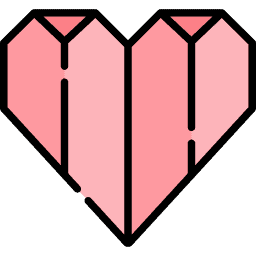
Origami a fabulous activity for children of all ages, as well as adults.
It’s even more special when you join your child in this ancient art.
Taking your first step into the world of origami can feel intimidating, but don’t worry. All you need are some clear instructions, a sheet of paper, and some patience.
Once you have these three, you can start learning this fascinating and still evolving art form.
